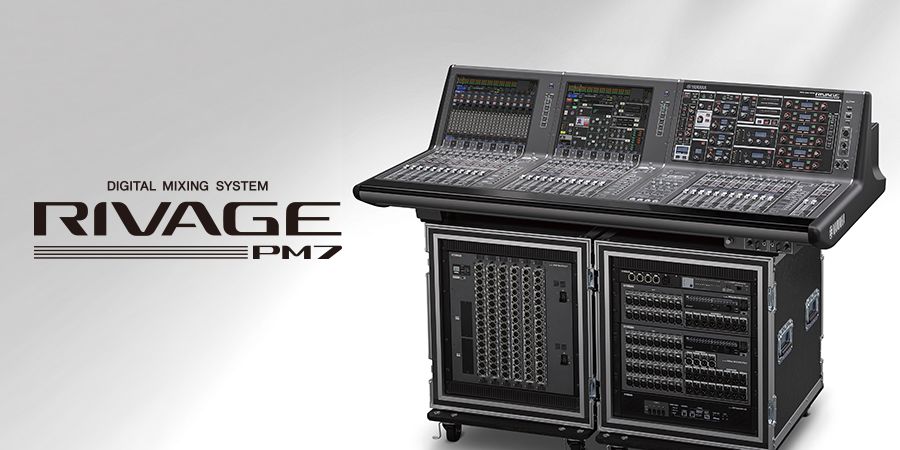New RIVAGE PM7 System Offers the RIVAGE PM10 User Experience with Integrated Portability and Flexibility

February 6, 2018. Shizuoka, Japan. – Yamaha Corporation announces an important new addition to the professional audio lineup: the RIVAGE PM7 Digital Mixing System. The core of the RIVAGE PM7 system includes the CSD-R7 Digital Mixing Console, Dante based Rio3224-D2 and Rio1608-D2 I/O Racks, and TWINLANe based RPio622 and RPio222 I/O Racks.
The CSD-R7 Digital Mixing Console is the central component of the RIVAGE PM7 system, positioned directly below the current RIVAGE PM10 Digital Mixing System in the Yamaha lineup. The CSD-R7 is the same size as the RIVAGE PM10 system CS-R10 control surface, but with the DSP engine built into the console it offers enhanced portability and system flexibility while maintaining high operability. The dimensions and panel layout of the RIVAGE PM7 are the same as the flagship RIVAGE PM10, delivering the same user experience. The RIVAGE PM7 has 120 input channels, 60 mix buses, 24 matrices, and a comprehensive selection of 48 top-quality plug-ins, providing mixing capacity that is comparable to the RIVAGE PM10 (the latter has 144 input channels, 72 mix buses, 36 matrices, and 50 plug-ins). A Dual Console function also allows the CSD-R7 to be connected to one of the RIVAGE PM10 system control surfaces (CS-R10 or CS-R10-S). A CS-R10-S can be used at FOH or in the wings for monitor mixing duty, or as a sidecar expansion console for the CSD-R7, depending on space and system scale requirements.
The CSD-R7 Digital Mixing Console offers connectivity with two types of audio networks, allowing either or both to be used for connection to I/O Rack units. The dedicated TWINLANe network uses optical cable to handle up 400 channels of audio. Combinations of the RPio622 and/or RPio222 I/O racks and HY256-TL or HY256-TL-SMF audio interface cards allow input via Hybrid Microphone Preamplifiers with analog input stages that take the Yamaha “natural sound” concept to new heights, as well as digital sections with immaculate VCM-technology models of Rupert Neve Designs transformer and SILK processing circuitry that offer outstanding musicality and atmosphere. Then there’s the Dante audio network from Audinate, already standard in CL and QL series digital consoles as well as a range of other Yamaha pro audio products. Rio3224-D2 and Rio1608-D2 I/O Racks, to be released simultaneously as RIVAGE PM7 system components, and the HY144-D audio interface card can be combined to provide natural sound input at full RIVAGE PM series quality, allowing the on-stage sound to be cleanly captured and shaped as required by the engineer. Yamaha’s unwavering approach to live sound reinforcement is wholly inherited in the RIVAGE PM7.
In addition to the new components, Version 2.0 of the RIVAGE PM series firmware will include a number of new features such as 5.1 surround and mix minus capability for broadcast applications, Rupert Neve Designs Portico 5045 Primary Source Enhancer, the Dual Console function, DSP mirroring (RIVAGE PM10 only), and more.
5.1 surround panning and monitoring are provided for broadcast applications, and two surround buses are available for efficient international feed production. A broadcast Mix Minus function is provided too, allowing a specified source to be removed from a specified remote feed with just a few steps. The easy-operation Rupert Neve Designs Portico 5045 effectively suppresses background noise at microphone inputs for enhanced clarity while significantly increasing the feedback margin, making it a valuable tool for live sound in houses of worship, stadiums, halls, and other environments where feedback can be problem.
DSP Mirroring is a RIVAGE PM10 only function that allows two DSP-R10 DSP engines to be used for failsafe redundancy. If a problem occurs in the main DSP-R10 unit, the second DSP-R10 can take over without disrupting the program.
Josh Thomas, general manager at Rupert Neve Designs, had the following to say: “Rupert Neve, I and the rest of the team here at Rupert Neve Designs are incredibly proud and pleased with the results that Yamaha has achieved with both the Silk and 5045 emulations. It’s uncanny how close they are, and add an amazing power and flexibility to the already formidable Yamaha Mixer lineup.”
Yoshi Tsugawa, general manager of Yamaha’s Pro Audio Division, comments: “The primary goal of the RIVAGE PM7 is to offer the same user experience provided by our flagship RIVAGE PM10 system to a wider range of customers. The RIVAGE PM10, firmware version 2.0, and the new RIVAGE PM7 comprise a strong, versatile lineup that can accommodate today’s diversified business needs.
The RIVAGE PM7 and V2.0 firmware are scheduled for release soon.
*Product and company names and logos that appear in this news release are trademarks of their respective owners.



